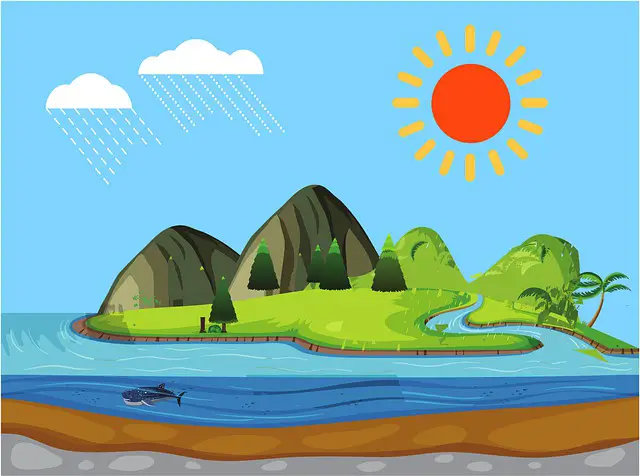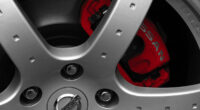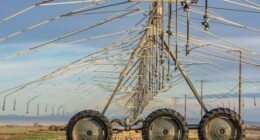Percolation and infiltration are two vital processes that impact the movement of water through soil. Percolation occurs when water moves through the small spaces between soil particles and eventually reaches an impermeable layer or bedrock. On the other hand, infiltration is a process where water penetrates into the soil and is absorbed by plants or seeps into groundwater.
What is percolation?
(Photo By Gunnar Ries zwo on Flickr)

Percolation is the process of water moving through soil or rock layers, driven by gravity. When precipitation occurs, some of the water is absorbed into the ground and percolates downward until it reaches an impermeable layer such as bedrock or clay. The rate of percolation depends on various factors including soil type, slope gradient, vegetation cover and rainfall intensity.
During percolation, water can dissolve minerals from the surrounding rocks and soil particles which can lead to (chemical) weathering processes. Additionally, groundwater recharge occurs when water moves deeper underground where it replenishes aquifers that are important sources for drinking water.
Percolation also plays a crucial role in reducing surface runoff during heavy rains since much of the rainwater infiltrates into the ground rather than flowing overland into rivers or other bodies of water. This helps prevent flooding and erosion while promoting sustainable use of natural resources.
What is infiltration?
Infiltration is the process by which water seeps into the soil from the surface. It occurs when precipitation or irrigation exceeds evaporation, and water saturates the soil beyond its holding capacity. The infiltrated water moves downward through gravity and capillary forces until it reaches a layer of impermeable rock or hardpan that limits its further flow.
Infiltration plays an essential role in regulating the hydrological cycle, as it replenishes groundwater reserves, recharges streams and rivers, sustains vegetation growth, and mitigates erosion. Infiltration rates vary depending on several factors such as soil texture, structure, porosity, compaction degree, slope angle, land use practices among others.
Low infiltration rates can lead to surface runoff that carries pollutants and sediments into nearby bodies of water causing adverse environmental impacts. On the other hand high infiltration rates may result in groundwater recharge depletion leading to long-term drought conditions.
To improve infiltration rates various strategies are used such as conservation tillage practices that reduce soil disturbance; mulching with organic matter to increase soil moisture retention; planting deep-rooted crops that break up compacted soils; constructing permeable pavements for urban areas among others.
Percolation Vs. Infiltration – Key differences
Percolation and infiltration are two terms often used in environmental sciences, particularly in hydrology. Although they may sound similar, there are significant differences between the two.
Percolation refers to the process of water moving downward through soil or other porous materials due to gravity. This movement can be slow or fast depending on factors such as soil texture, porosity, and hydraulic conductivity.
Infiltration, on the other hand, is when water enters the ground surface from precipitation or irrigation sources. It is essentially the initial stage of percolation where water moves into soils before it starts moving downwards.
The key difference between percolation and infiltration lies in their directionality. Percolation involves downward movement while infiltration is upward movement into soil layers above a lower layer of impermeable rock or clay.
Another difference lies in their effects on groundwater recharge rates. Infiltrated water reaches groundwater aquifers faster than percolating water since it bypasses some shallow subsurface layers that may not contribute much to recharging these aquifers.
While both processes play essential roles in regulating ecosystems’ hydrologic cycle, they differ significantly regarding how contaminants move with them within soil layers.
What are the benefits of percolation?
Percolation offers numerous benefits, both for the environment and human activities. One of its primary advantages is its role in replenishing groundwater resources. As water percolates through soil layers, it recharges aquifers and contributes to the overall sustainability of our water supply.
In addition to ensuring a reliable source of drinking water, percolation also helps maintain healthy ecosystems. It supports vegetation growth by providing adequate moisture for plant roots; this not only enhances soil fertility but also prevents erosion due to rainwater runoff.
Moreover, percolation aids in natural filtration processes that remove pollutants from surface waters. As water infiltrates through various substrata, potentially harmful substances are adsorbed or decomposed by microorganisms present in the soil matrix. Consequently, cleaner water reaches deeper levels where it can be used safely by humans and wildlife alike.
Enhanced percolation rates contribute positively to flood mitigation efforts – particularly in urban settings with high levels of impervious surfaces such as pavement or rooftops. By promoting infiltration rather than surface runoff during heavy rainfall events, well-designed stormwater management systems can minimize the risk of flooding while simultaneously improving overall watershed health.
What are the benefits of infiltration?
Infiltration, the process of water seeping into the soil and replenishing groundwater resources, offers numerous benefits to both natural ecosystems and human communities.
Firstly, infiltration helps to reduce soil erosion by allowing rainwater to be absorbed into the ground instead of running off over land surfaces. This reduces sediment buildup in streams and rivers, which in turn improves water quality for aquatic life.
Infiltration also plays a critical role in maintaining healthy plant growth. As water penetrates the soil, it dissolves essential nutrients that are then taken up by plants through their roots. Without adequate infiltration rates, many crops would not be able to grow properly.
Furthermore, infiltrated water can help recharge underground aquifers that provide drinking water for millions of people worldwide. By infusing these aquifers with fresh supplies of clean groundwater, infiltration ensures long-term access to safe drinking water supplies.
Infiltration can help mitigate flooding events by reducing peak runoff flows during heavy rainfall events. When rainwater is absorbed into the ground rather than flowing across impervious surfaces like concrete or asphalt roads and parking lots – it has less chance of causing flash floods downstream.
Infiltration provides an array of ecological and societal benefits that make it a critical component of sustainable development efforts throughout the world.
What is the difference between percolation and leaching?
Percolation and leaching are often used interchangeably, but they have significant differences. Percolation occurs when water moves through porous soil or rock materials to reach the groundwater table. On the other hand, leaching is a process by which water-soluble substances such as minerals or chemicals are washed out from the soil into lower layers of earth with no specific direction.
Percolation is a critical part of natural filtration systems that help purify contaminated water sources. It involves filtering impurities from surface runoff before it reaches underground aquifers without causing any substantial pollution. Leaching can lead to environmental degradation and contamination of groundwater sources since it washes away essential nutrients in soils, leading to poor soil quality.
The primary difference between percolation and leaching lies in their intended direction and consequences on surrounding environments. In percolation, water flows downwards through permeable materials towards an aquifer’s recharge zone while removing pollutants along its path’s way. Leaching results in loss of nutrients and potential pollution risks for nearby ecosystems if not controlled properly.
In summary, percolation focuses on purifying polluted waters while recharging underground reserves without harming nature’s ecosystem balance. Meanwhile, leaching removes valuable materials from soils at higher risk of contaminating groundwater reservoirs downstream without proper management techniques implemented beforehand.
What is precipitation?
Precipitation is a natural process in which water droplets or ice crystals fall from the atmosphere onto the Earth’s surface. It can come in various forms such as rain, snow, hail, and sleet. Precipitation plays a crucial role in sustaining life on our planet by providing water for plants and animals to drink, irrigate crops, generate power through hydroelectricity and replenish freshwater sources.
Precipitation occurs when warm air rises into the atmosphere carrying moisture with it. As the air cools down at higher altitudes, it cannot hold as much moisture as before causing condensation of water vapor into clouds. Eventually, these clouds become heavy enough that they cannot support their weight anymore resulting in precipitation.
The amount of precipitation that falls varies depending on many factors such as humidity levels, temperature changes and wind patterns. In some areas of the world where there is little rainfall throughout the year like deserts or arctic regions, precipitation is scarce making it difficult for plant life to survive.
Precipitation acts as an essential component of our planet’s ecosystem by maintaining balance between land surfaces and oceans while also contributing significantly to climatic conditions across different continents around the globe.
featured Image By – Venita Oberholster from Pixabay









